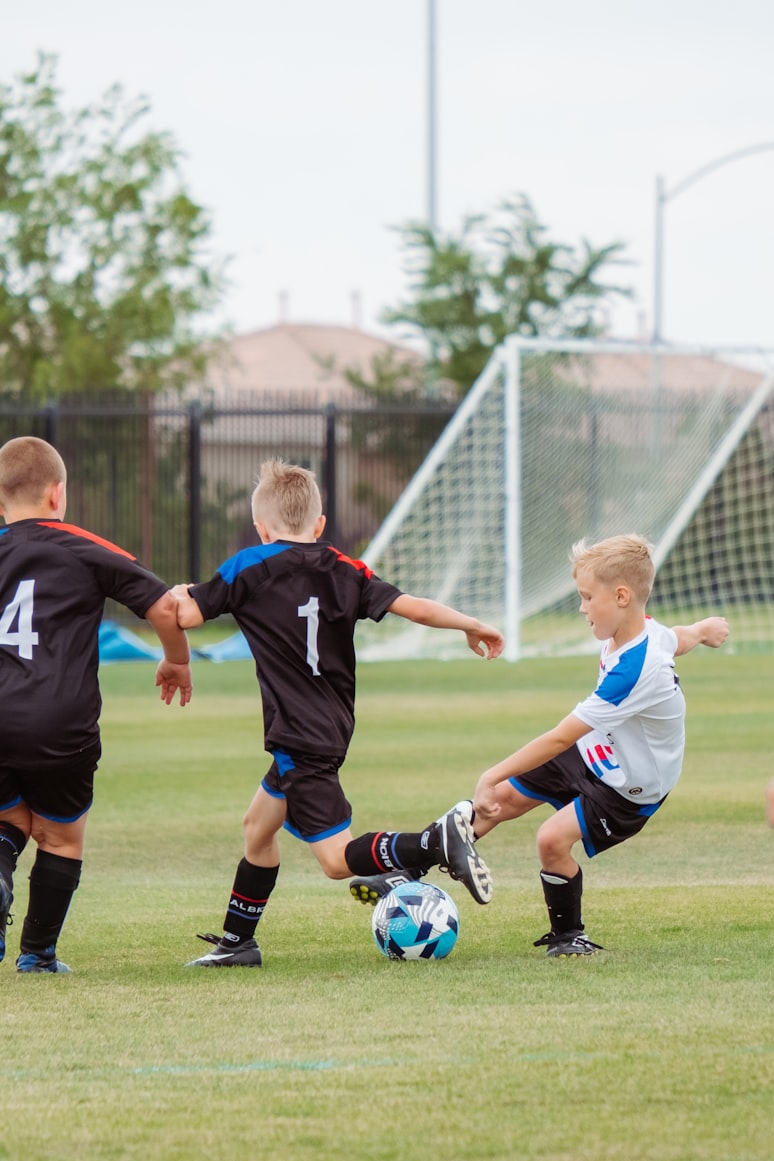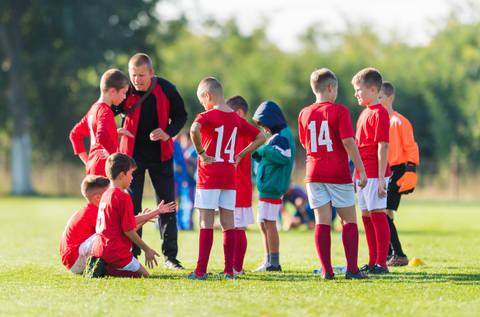
It can be difficult to know when to introduce the concept of tactics to young players.
There is a school of thought that they should just be allowed to play freely without being overloaded with information or bogged down with concerns that they might be standing in the right or wrong place.
However, there is no doubt that some appreciation of formation gives young players a good awareness of the game and will stand them in good stead as they develop through the age groups. It’s definitely never too early to get them thinking about the game.
Even under 10’s and below where many are still playing 7 a side soccer is a good time to think about different roles and responsibilities. Here’s a look at some basic 7 a side formations you might want to consider for your junior team.
Solid Base: 3-2-1
If you’re unsure if you’ll match the strength of your opponent this is one of the best soccer formations for 7v7 that will enable you to be competitive in the game. Also, this helps teams who might have players who struggle for pace and lack recovery.
A solid back three with little responsibility other than to defend the goal means you’ll always be competitive and rarely be countered attacked. The dispersal of the 2 midfielders in front means your back players will usually find themselves with passing options forward and the two wide defenders can always play into the central striker’s feet or down the side into the channels which are safe areas of the pitch to play the game in.
This formation is supported by a forward who can operate with his back to goal and is also prepared to chase balls into these channels, unsettling defenders and winning free kicks in the final third.
Pros: Arguably the best formation for 7v7 soccer when facing a stronger opponent. Can aid defenders who are one paced and less confident in possession of the ball.
Cons: Can easily surrender possession and spend a long time defending. Front man can become frustrated and tired from chasing balls into the channels.
Balanced: 2-2-2
As with the 4-4-2 formation in full sized soccer games, this balanced formation appeals to coaches who want to make occupying the pitch a central theme of their 7v7 soccer strategy. It guarantees an overall balance between attack and defence as well as build up and transition.
When playing forward this formation is supported by the two midfield players breaking wide to either receive the ball or create a channel to play into the front two.
The two front players operate in tandem with good interplay and are given support from arriving midfield players.
Pros: Simple strategy to implement. Unlikely to be found ‘out of shape’
Cons: Offers little opportunity for structured build up.
Counter attack: 4-1-1
The success of this shape relies upon the fitness of the two wide defenders who need enough stamina to play as high as the ball at any time. This enables the team to defend with 4, but break with 3 in midfield or 3 in attack depending on where the ball is in play.
The two wide player either supplement the central midfielder or attacker to gain a positive overload. This is a fantastic formation for defending in numbers and then breaking at pace to counter attack your opposition.
Pros: If the 2 wide players are fit enough to be as high as the ball then your team is virtually assured to outnumber the opposition as play develops.
Cons: Can become exposed down either side if the wide players don’t stay the pace.
Direct: 3-1-2
This is the best 7v7 formation to provide your team with a good shape to get the ball from back to front quickly and play with two strikers in tandem to provide a threat. Again, a solid back line of 3 provide a good defensive barrier in the back third of the pitch. Their other function is to serve the ball up to the two attackers who work together to secure the ball high up the pitch and create chances to score.
There is little in the way of patient build up with the ball being played forward in a more direct style.
Pros: With a good front two who have a good understanding it can be
very difficult to defend against. Strong defensive base also allows for possession to be concentrated in safe areas of the pitch.
Cons: Can be easily nullified by opposition with good defensive players or a good screening midfield player. Own midfield player can become isolated and have limited options on the ball.
Control the ball: 2-3-1
This is the most popular soccer formation for 7v7 with the majority of teams opting to use it. It offers good opportunities to play a possession based game by recycling the ball between the defenders and the midfield players. A forward pass into the single striker allows the midfield players to be released to support and become a threat.
When defending, the 3 midfield players have the option of pressing high up the pitch to try and win the ball back early or to drop in front of the defenders and provide a defensive screen. This flexibility is one of the reasons why so many people consider it to be the best 7v7 soccer formation.
Pros: This formation offers strong defensive cover as the midfield can act as a screen to the defenders or press to win the ball high up the field. Possession can be retained comfortably by recycling the ball with ‘safe’ passes between the midfield and defence before playing forward when there is an opening.
Cons: Attacker can become isolated for long spells. Can spend long spells in possession without threatening the goal.
Stretch the Pitch: 2-1-3
This 7 v 7 strategy offers a real opportunity to stretch the pitch and play an open, expansive game. The 2 defenders split wide when the goalkeeper has the ball providing options and creating a central channel for the single midfield player to receive the ball to feet either from the goalkeeper or one of the two defenders. Here he can either play ‘around the corner’ into the feet of one of the attackers or set the ball back for a defender to play forward if tightly marked.
The 3 attacking players can stretch across the full width of the pitch allowing for simple balls into feet or the option of coming in off the line to join build up play or attack balls across the front of the goal.
Pros: With good players who are comfortable on the ball this can be difficult to defend against and can guarantee your team long spells of possession. You can tire the opposition by playing a strong possession based game.
Cons: This is a formation which is wide open to counter attacks. Players need to be disciplined and fit enough for transition into a tighter defensive shape when possession is lost.
Advanced Formation: Rotational Diamond 2-1-2-1
This is arguably the best soccer formation for 7v7 allowing for complex interchanges and build up play.
With 2 defensive players forming a solid base, the remaining 4 players operate in a rotational diamond with any of the four playing as the deep midfielder, either wide midfielder or point attacker at any time. The four in the diamond can either rotate clockwise or anti-clockwise or switch corner positions when the defenders are in possession to enable the ball to be played football to an unmarked player on the ‘half turn’.
This can lead to lots of possession and chances created.
Pros: When implemented correctly this is very difficult to defend against and will guarantee chances for your team to score
Cons: This formation requires a good understanding between all the team members and practice to get it right.
If none of this works for you then why not just give your players some roles and responsibilities to think about as they move naturally during the game and the "formation" will take care by itself!
Tools you can use to plan and tweak
As you've seen there's many variations of line-ups and tactics that you can employ for 7 aside football - it can be difficult to decide which to use for your own team and players.
There are many online tools and apps available that can help you experiment and decide what might work best.
TeamStats is one - the line up planner is part of a suite of features for use by grassroots teams to assist with management and administration.


















